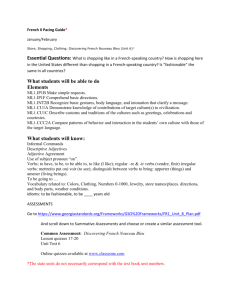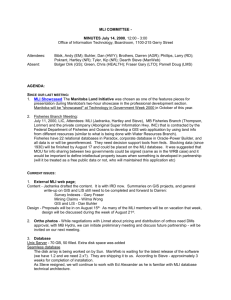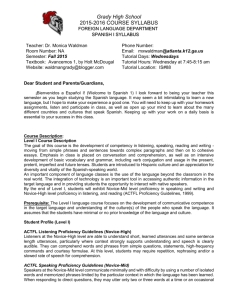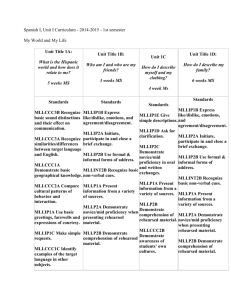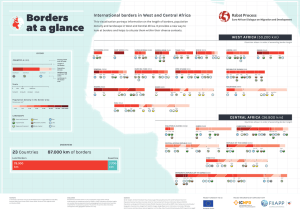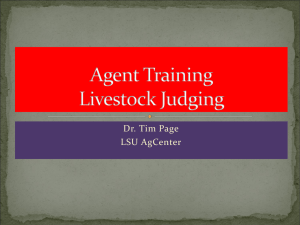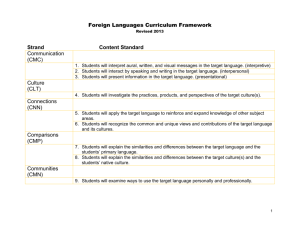MODERN FOREIGN LANGUAGES – PACING GUIDE FOR
advertisement
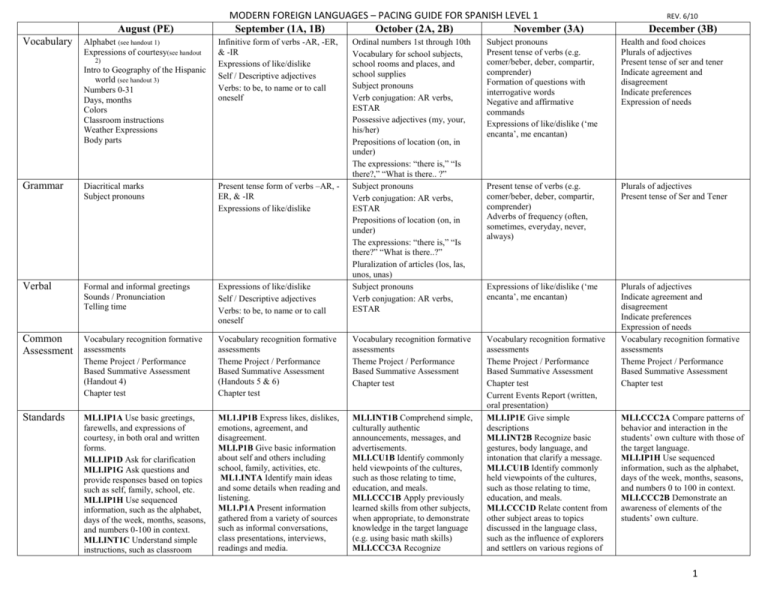
August (PE) Vocabulary Alphabet (see handout 1) Expressions of courtesy(see handout MODERN FOREIGN LANGUAGES – PACING GUIDE FOR SPANISH LEVEL 1 September (1A, 1B) October (2A, 2B) November (3A) Subject pronouns Present tense of verbs (e.g. comer/beber, deber, compartir, comprender) Formation of questions with interrogative words Negative and affirmative commands Expressions of like/dislike (‘me encanta’, me encantan) Health and food choices Plurals of adjectives Present tense of ser and tener Indicate agreement and disagreement Indicate preferences Expression of needs Present tense of verbs (e.g. comer/beber, deber, compartir, comprender) Adverbs of frequency (often, sometimes, everyday, never, always) Plurals of adjectives Present tense of Ser and Tener Expressions of like/dislike (‘me encanta’, me encantan) Theme Project / Performance Based Summative Assessment (Handout 4) Chapter test Vocabulary recognition formative assessments Theme Project / Performance Based Summative Assessment (Handouts 5 & 6) Chapter test Vocabulary recognition formative assessments Theme Project / Performance Based Summative Assessment Chapter test MLI.IP1A Use basic greetings, farewells, and expressions of courtesy, in both oral and written forms. MLI.IP1D Ask for clarification MLI.IP1G Ask questions and provide responses based on topics such as self, family, school, etc. MLI.IP1H Use sequenced information, such as the alphabet, days of the week, months, seasons, and numbers 0-100 in context. MLI.INT1C Understand simple instructions, such as classroom ML1.IP1B Express likes, dislikes, emotions, agreement, and disagreement. MLI.P1B Give basic information about self and others including school, family, activities, etc. ML1.INTA Identify main ideas and some details when reading and listening. ML1.P1A Present information gathered from a variety of sources such as informal conversations, class presentations, interviews, readings and media. MLI.INT1B Comprehend simple, culturally authentic announcements, messages, and advertisements. MLI.CU1B Identify commonly held viewpoints of the cultures, such as those relating to time, education, and meals. MLI.CCC1B Apply previously learned skills from other subjects, when appropriate, to demonstrate knowledge in the target language (e.g. using basic math skills) MLI.CCC3A Recognize Vocabulary recognition formative assessments Theme Project / Performance Based Summative Assessment Chapter test Current Events Report (written, oral presentation) MLI.IP1E Give simple descriptions MLI.INT2B Recognize basic gestures, body language, and intonation that clarify a message. MLI.CU1B Identify commonly held viewpoints of the cultures, such as those relating to time, education, and meals. MLI.CCC1D Relate content from other subject areas to topics discussed in the language class, such as the influence of explorers and settlers on various regions of Plurals of adjectives Indicate agreement and disagreement Indicate preferences Expression of needs Vocabulary recognition formative assessments Theme Project / Performance Based Summative Assessment Chapter test 2) Grammar Diacritical marks Subject pronouns Present tense form of verbs –AR, ER, & -IR Expressions of like/dislike Verbal Formal and informal greetings Sounds / Pronunciation Telling time Expressions of like/dislike Self / Descriptive adjectives Verbs: to be, to name or to call oneself Common Vocabulary recognition formative Assessment assessments Standards December (3B) Ordinal numbers 1st through 10th Vocabulary for school subjects, school rooms and places, and school supplies Subject pronouns Verb conjugation: AR verbs, ESTAR Possessive adjectives (my, your, his/her) Prepositions of location (on, in under) The expressions: “there is,” “Is there?,” “What is there.. ?” Subject pronouns Verb conjugation: AR verbs, ESTAR Prepositions of location (on, in under) The expressions: “there is,” “Is there?” “What is there..?” Pluralization of articles (los, las, unos, unas) Subject pronouns Verb conjugation: AR verbs, ESTAR Intro to Geography of the Hispanic world (see handout 3) Numbers 0-31 Days, months Colors Classroom instructions Weather Expressions Body parts Infinitive form of verbs -AR, -ER, & -IR Expressions of like/dislike Self / Descriptive adjectives Verbs: to be, to name or to call oneself REV. 6/10 MLI.CCC2A Compare patterns of behavior and interaction in the students’ own culture with those of the target language. MLI.IP1H Use sequenced information, such as the alphabet, days of the week, months, seasons, and numbers 0 to 100 in context. MLI.CCC2B Demonstrate an awareness of elements of the students’ own culture. 1 MODERN FOREIGN LANGUAGES – PACING GUIDE FOR SPANISH LEVEL 1 procedures and basic computer terminology. MLI.CCC1A Demonstrate knowledge of geographical locations and identify major countries, cities, and geographical features of the places where the target language is spoken. MLI.CCC1C Identify examples of vocabulary, phrase, proverbs, and symbols from the target language that are used in other subjects. MLI.CCC3 Recognize similarities/ differences between target language and English. MLI.CCC3B Recognize basic sound distinctions and intonation patterns and their effects on communicating meaning. MLI.IP1F Comprehend basic directions. MLI.CCC5 Identify examples of target language and culture in media forms. ML1.CCC.5B Identify resources, such as individuals and organizations accessible through the community or the Internet, that provide basic cultural information about the culture studied. MLI.IP2A Initiate and participate in, and close a brief oral or written exchange. MLI.P2A Demonstrate NoviceMid proficiency in pronunciation and intonation when presenting rehearsed material. MLI.P2B Demonstrate comprehension of rehearsed material. similarities and differences in sound systems, writing systems, cognates, gender, and level appropriate idioms. ML1.CCC5A Identify examples of the target language and the culture studied that are evident in and through media, entertainment, and technology. MLI.INT1D Demonstrate NoviceMid proficiency in listening sand reading comprehension. MLI.IP2B Use formal and information forms of address REV. 6/10 the United States. MLI.INT2A Differentiate among statements, questions, and exclamations. MLI.CU1A Demonstrate knowledge of contributions of target culture(s) to civilization. MLI.CCC4A Give information regarding major current events of the target culture MLI.CCC4B Understand the impact of current events of the target culture Instructors should use this as a pacing guide. Based on use of Prentice Hall Realidades 1 Textbook Standards are not repeated in subsequent chapters. This pacing guide only lists the first instance of a standard. 2 MODERN FOREIGN LANGUAGES – PACING GUIDE FOR SPANISH LEVEL 1 REV. 6/10 HANDOUT 1 3 MODERN FOREIGN LANGUAGES – PACING GUIDE FOR SPANISH LEVEL 1 REV. 6/10 HANDOUT 2 4 MODERN FOREIGN LANGUAGES – PACING GUIDE FOR SPANISH LEVEL 1 REV. 6/10 HANDOUT 3 5 MODERN FOREIGN LANGUAGES – PACING GUIDE FOR SPANISH LEVEL 1 REV. 6/10 HANDOUT 4 6 MODERN FOREIGN LANGUAGES – PACING GUIDE FOR SPANISH LEVEL 1 REV. 6/10 HANDOUT 5 7 MODERN FOREIGN LANGUAGES – PACING GUIDE FOR SPANISH LEVEL 1 REV. 6/10 HANDOUT 6 Nombre: Clase: RUBRIC How much information you communicate Score 1 Puntos: Score 3 Score 5 You mention one detailed example in each category You mention three activities and all three categories You mention five activities and all three categories How easily you are understood You are difficult to understand and have many patterns of grammatical errors You are fairly easy to understand with occasional patterns of grammatical errors You are easy to understand and have very few patterns of grammatical errors How clearly and neatly your visuals match what you are saying You include three visuals that clearly connect to activities You include three visuals that clearly connect to activities You include five visuals that clearly connect to activities Objective: Materials: Activity: Students will present information that describes their preferences using verbs from chapter 1A. Textbook; internet; Powerpoint; cameras; video recorder Students will begin by completing a three column chart labeled Me Gusta…, Me Gusta Mucho…, No Me Gusta Nada… Under these columns students will write verbs that identify activities they like, they like a lot, and don’t like at all. Students then need to create a presentation using visual representation of the activities acquired from magazines, photographs or the web and present the information to the class. Standards: MLI.IP1B – Express likes, dislikes, emotions, agreement and disagreement MLI.P1B – Students give basic information about self and others including school, family, activities, etc. MLI.P2A – Demonstrate Novice-Mid proficiency in pronunciation and intonation when presenting rehearsed material. MLI.P2B – Demonstrate comprehension of rehearsed material 8 MODERN FOREIGN LANGUAGES – PACING GUIDE FOR SPANISH LEVEL 1 REV. 6/10 HANDOUT 7 9
